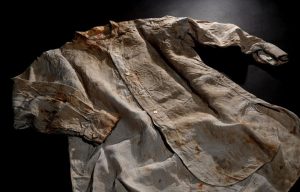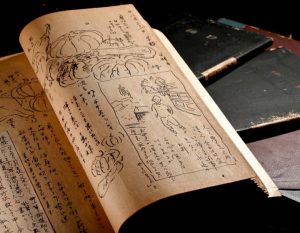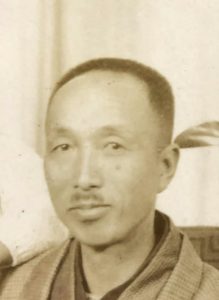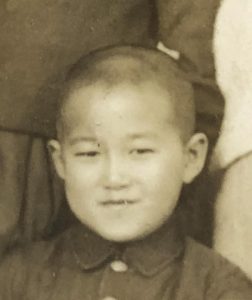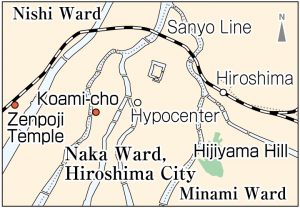Blood-stained shirt donated last spring to the Peace Museum tells of child’s last moment
Jan. 16, 2023
“I wanted to cry out for my child, who would never come back.” Father describes his sorrow in his dairy.
by Junji Akechi, Staff Writer
There remains a shirt placed on a boy, who was burned with the A-bomb’s heat rays, by his father in his last moment. The adult-sized thin-striped shirt has vivid stains of blood and ointment. There also remains a handwritten diary of the father’s kept at his family’s home in Hiroshima’s Nishi Ward, wherein he spelled out his unhealed grief after the war. They convey the sufferings of the family caused by the atomic bombing.
The boy who died in the atomic bombing was Hiroshi Higaki, then a 14-year-old second-year student at Hiroshima Municipal Junior High School (now Hiroshima Municipal Motomachi Senior High School). On August 6, 1945, he and his classmates, along with other second-year students, were mobilized to the Koami-cho area (now part of Naka Ward), about 900 meters from the hypocenter, to demolish homes to create fire lanes. Hyoichi, Hiroshi’s father who died in 1973 at the age of 79, describes the situation when he bid final farewell to his son in his memoir submitted to the Hiroshima City government, which compiled and published “Genbaku Taikenki” (Experiences of the Atomic Bombing) in 1950.
On that day, Hyoichi was at Zenpoji Temple in Koi-machi (now part of Nishi Ward), where his workplace had been evacuated. He tried to go back home near Hijiyama Hill in Minami-machi (now part of Minami Ward) after the bomb’s explosion, but the conflagration in the city center prevented him from moving forward. So he returned to the temple, where Hiroshi had fled to for his own safety. Hiroshi was lying, suffering serious burns to his face, hands, and upper half of his body. Hyoichi’s diary said: “He looked like a skinned rabbit. I knew instinctively to all appearances that he wouldn’t make it.”
Hyoichi put the adult-sized shirt on Hiroshi, who was half-naked, and made him drink water. “Dad, I can’t see,” “My chest feels tight,” Hiroshi complained. In spite of Hyoichi’s care, he would not last through the night of August 6. The next day, Hyoichi cremated his son by himself.
“He often grieved over Hiroshi’s death, saying he died in a tragic way,” recalled Hiroshi’s younger brother Takashi, 86, Nishi Ward, remembering his father after the war. Takashi escaped death at the time of the bombing because he had evacuated along with a group of school children to what is present Shobara City. He keeps his father’s diary, written two years after the atomic bombing, in which he expressed his sorrow.
On August 6 of 1947, Hyoichi attended the memorial service for the Hiroshima Municipal Junior High School students at a temple in Koami-cho while the first Peace Festival, a precursor of the Peace Memorial Ceremony, was held. “I wanted to cry out for my child, who would never come back,” he wrote. In the diary dated August 31, he described his painful feeling as a parent with a picture of Hiroshi smiling: “When this trauma would be healed? Sometimes I wish my son would come back, like a fairy tale.”
Hyoichi’s wife Yoshino died in 1949 from a wound suffered in the atomic bombing. Hyoichi moved a lot, but never parted with the shirt steeped in his beloved son’s blood, storing it in a paper box. Takashi kept the shirt after his father’s death. However, he became old and donated it to the Hiroshima Peace Memorial Museum (Naka Ward) last spring, hoping many people would see it.
Takashi has not spoken about the A-bomb story of his family before, and requested the museum withhold his name as a donor. Even so, he agreed to the interview under his real name because “I am the last person who knows my brother.”
“This is nothing special, but…,” Takashi rolled up his right trouser leg and showed a small black spot on his shin. “When we had a fight in our childhood, my brother pricked me with a pencil. This is the pencil lead. I leave it as it is, and will not take it out because it’s my brother’s.” The scar from the fight (he can’t even recall why it even began) is a bit of evidence that he had a brother who always cared for him.
(Originally published on August 5, 2022)
There remains a shirt placed on a boy, who was burned with the A-bomb’s heat rays, by his father in his last moment. The adult-sized thin-striped shirt has vivid stains of blood and ointment. There also remains a handwritten diary of the father’s kept at his family’s home in Hiroshima’s Nishi Ward, wherein he spelled out his unhealed grief after the war. They convey the sufferings of the family caused by the atomic bombing.
The boy who died in the atomic bombing was Hiroshi Higaki, then a 14-year-old second-year student at Hiroshima Municipal Junior High School (now Hiroshima Municipal Motomachi Senior High School). On August 6, 1945, he and his classmates, along with other second-year students, were mobilized to the Koami-cho area (now part of Naka Ward), about 900 meters from the hypocenter, to demolish homes to create fire lanes. Hyoichi, Hiroshi’s father who died in 1973 at the age of 79, describes the situation when he bid final farewell to his son in his memoir submitted to the Hiroshima City government, which compiled and published “Genbaku Taikenki” (Experiences of the Atomic Bombing) in 1950.
On that day, Hyoichi was at Zenpoji Temple in Koi-machi (now part of Nishi Ward), where his workplace had been evacuated. He tried to go back home near Hijiyama Hill in Minami-machi (now part of Minami Ward) after the bomb’s explosion, but the conflagration in the city center prevented him from moving forward. So he returned to the temple, where Hiroshi had fled to for his own safety. Hiroshi was lying, suffering serious burns to his face, hands, and upper half of his body. Hyoichi’s diary said: “He looked like a skinned rabbit. I knew instinctively to all appearances that he wouldn’t make it.”
Hyoichi put the adult-sized shirt on Hiroshi, who was half-naked, and made him drink water. “Dad, I can’t see,” “My chest feels tight,” Hiroshi complained. In spite of Hyoichi’s care, he would not last through the night of August 6. The next day, Hyoichi cremated his son by himself.
“He often grieved over Hiroshi’s death, saying he died in a tragic way,” recalled Hiroshi’s younger brother Takashi, 86, Nishi Ward, remembering his father after the war. Takashi escaped death at the time of the bombing because he had evacuated along with a group of school children to what is present Shobara City. He keeps his father’s diary, written two years after the atomic bombing, in which he expressed his sorrow.
On August 6 of 1947, Hyoichi attended the memorial service for the Hiroshima Municipal Junior High School students at a temple in Koami-cho while the first Peace Festival, a precursor of the Peace Memorial Ceremony, was held. “I wanted to cry out for my child, who would never come back,” he wrote. In the diary dated August 31, he described his painful feeling as a parent with a picture of Hiroshi smiling: “When this trauma would be healed? Sometimes I wish my son would come back, like a fairy tale.”
Hyoichi’s wife Yoshino died in 1949 from a wound suffered in the atomic bombing. Hyoichi moved a lot, but never parted with the shirt steeped in his beloved son’s blood, storing it in a paper box. Takashi kept the shirt after his father’s death. However, he became old and donated it to the Hiroshima Peace Memorial Museum (Naka Ward) last spring, hoping many people would see it.
Takashi has not spoken about the A-bomb story of his family before, and requested the museum withhold his name as a donor. Even so, he agreed to the interview under his real name because “I am the last person who knows my brother.”
“This is nothing special, but…,” Takashi rolled up his right trouser leg and showed a small black spot on his shin. “When we had a fight in our childhood, my brother pricked me with a pencil. This is the pencil lead. I leave it as it is, and will not take it out because it’s my brother’s.” The scar from the fight (he can’t even recall why it even began) is a bit of evidence that he had a brother who always cared for him.
(Originally published on August 5, 2022)

